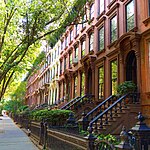Old First Reformed Church (Brooklyn)

The Old First Reformed Church in Brooklyn, New York– officially known as The Reformed Dutch Church of the Town of Breukelen – is a historic Dutch Reformed church at 126 7th Avenue on the corner of Carroll Street in the Park Slope neighborhood of Brooklyn, New York, New York. The congregation was founded in 1654 by decree of Governor Pieter Stuyvesant, as one of three "collegiate churches." The current church building was constructed in 1888–1893 and is a Late Gothic Revival style Indiana limestone building on a granite base. It measures 100 feet wide and 162 feet deep. The front facade features a 212-foot-high stone tower and spire.The church was listed on the National Register of Historic Places in 1998.
Excerpt from the Wikipedia article Old First Reformed Church (Brooklyn) (License: CC BY-SA 3.0, Authors, Images).Old First Reformed Church (Brooklyn)
Carroll Street, New York Brooklyn
Geographical coordinates (GPS) Address External links Nearby Places Show on map
Geographical coordinates (GPS)
| Latitude | Longitude |
|---|---|
| N 40.673333333333 ° | E -73.976388888889 ° |
Address
Old First Reformed Church
Carroll Street 729
11215 New York, Brooklyn
New York, United States
Open on Google Maps










